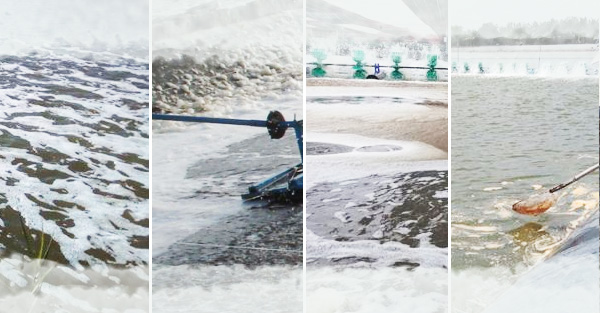White foam that does not dissolve in a short period of time might appear after paddlewheel aerators are run. This type of foam indicates that pond water has suspended sediments such as dead algae, organic matter from feed leftovers, algae, filamentous bacteria, soil particles and other suspended solid particles. Foam in shrimp pond can be white, yellowish brown or green, depending on the cause of foam.

Source of picture: Internet
If shrimp pond has a lot of white foam when running aerators (except for bubbles that appear due to the use of chemicals with foaming agents such as cleanser, saponins), its water quality is poor. If not handled promptly, pond water will affect the health of shrimp, cause diseases in shrimp gills, reduce feed intake, and result in slow growth.
If foam floats in the middle of the pond, or pond bottom has a lot of sludge (especially black mud with foul odor), that area accumulates and produces many toxic gases such as H2S and NH3. H2S and NH3 can poison shrimp; high concentrations of these gases can kill shrimp.
Solution for foam in pond: When white foam appears in shrimp ponds, according to Viet Linh, it is necessary to quickly handle this situation to reduce its impact on shrimp health.
- If foam is thick and floats at the edges of pond banks when running aerators, remove foam from the pond.
- Take away algae floating on the pond surface.
- Change part of the water if possible.
- Check shrimp and leftovers in feeding tray. Reduce the amount of feed continuously in 2-3 days to determine if shrimp reduces eating and the amount of algae is excessive.
- Run aerators and increase bottom oxygen to provide enough dissolved oxygen. Make sure that the level of dissolved oxygen is at least over 4 ppm.
- Apply lime in areas where waste and sediments are gathered, especially when pond water pH is low. Maintain pH in the range of 7.5 to 8.3.
- Use microorganisms to treat pond bottom and water.
- Use vitamins and minerals to mix with shrimp feed.
To prevent the appearance of white bubbles in the shrimp pond, these measures should be taken at the same time:
- Monitor environmental indicators such as pH, oxygen, alkaline levels.
- Calculate the amount of shrimp feed carefully; avoid excessive feed.
- Use microorganisms periodically.
- Use vitamins and minerals to mix with shrimp feed.
- Apply siphon to take out sludge or mud at pond bottom. Use lime when waste and sediments start to accumulate.
© April 27, 2020 Vietlinh.us
- Foam in shrimp pond (Vietnamese)
- Dissolved oxygen of water in shrimp pond
- Tags: shrimp; foam; feed intake; shrimp farming; pH; alkalinity; oxygen